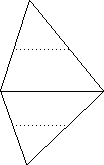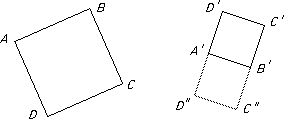To prove that (a1, 1), (a2, 1), ... , (ar , 1) are linearly independent, suppose that λ1(a1, 1) + λ2(a2, 1) + ... + λr(ar , 1) = 0 in Rn+1. Then we have λ1a1 + λ2a2 + ... + λrar = 0 in Rn and λ1 + λ2 + ... + λr = 0 in R and so from the definition of affine independence we have λ1 = λ2 = ... = λr = 0 and so the given set is linearly independent.
Given two affinely independent sets { a0 , a1 , ... , an } and { b0 , b1 , ... , bn } in Rnthe sets { a1 - a0 , ... , an - a0 } and { b1 - b0 , ... , bn - b0 } are linearly independent and so there is a unique linear map L taking one to the other. Then the map Tb0 ∘ L ∘T-a0 is the required affine map. It is easily seen to be unique.
 with A ∈GL(n, R). Then M maps a column
with A ∈GL(n, R). Then M maps a column  to a similar column and so acts on this affine subspace by
to a similar column and so acts on this affine subspace by  ↦
↦  where y = Ax + (a1, ... , an) Hence M acts as an affine transformation.
where y = Ax + (a1, ... , an) Hence M acts as an affine transformation.As in the last example, the n + 1 affinely independent points give n + 1 linearly independent points whose image determines a matrix and hence the map.
λ1f(a1) + λ2f(a2) + ... + λrf(ar) = λ1(a + L(a1)) + λ2(a + L(a2)) + ... + λr(a + L(ar)) which is the same since λ1 + λ2 + ... + λr = 0.
The centroid of { a1 , a2 , ... , ar } is 1/n(a1 + a2 + ... + ar) and so this is mapped to 1/n(f(a1) + f(a2) + ... + f(ar)) as required.
 A line joining the midpoints of two sides of a triangle is parallel to the third side.
A line joining the midpoints of two sides of a triangle is parallel to the third side. Hence the pair of sides shown is parallel. Similarly for the other pair of sides.
Hence the pair of sides shown is parallel. Similarly for the other pair of sides.The centroid of the quadrilateral is 1/4 (a + b + c + d). This is also the centroid of the parallelogram: 1/4 [(a + b)/2 + (b + c)/2 + (c + d)/2 + (d + a)/2] whose centroid is the meet of its diagonals.
This result does hold in R3 also.
 Take a square ABCD on AB and two possible squares A'B'C'D' and A'B'C''D'' on A'B'.
Take a square ABCD on AB and two possible squares A'B'C'D' and A'B'C''D'' on A'B'.Note that similarity transformations map squares to squares.
There is a unique affine map taking ΔABC to ΔA'B'C' and another (opposite) affine map taking ΔABC to ΔA'B'C'' and these are the required pair of similarities.